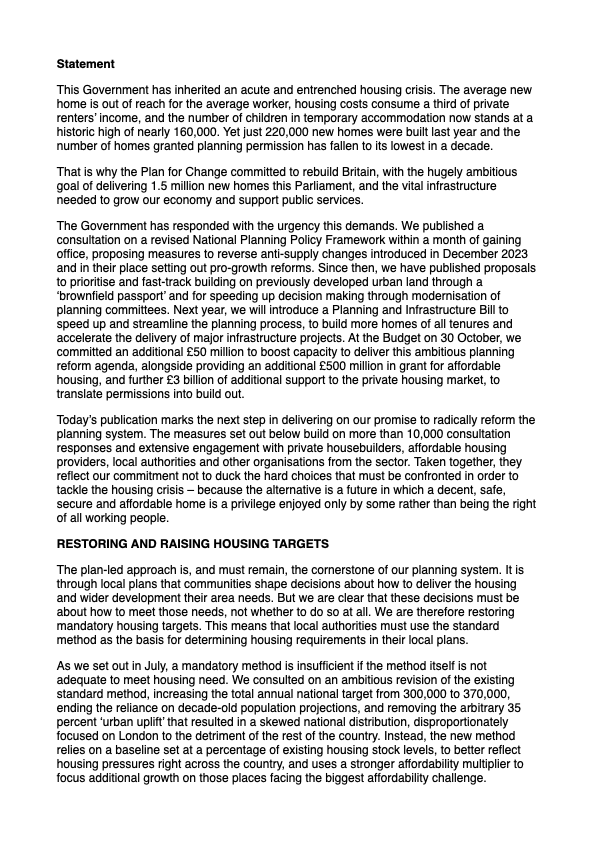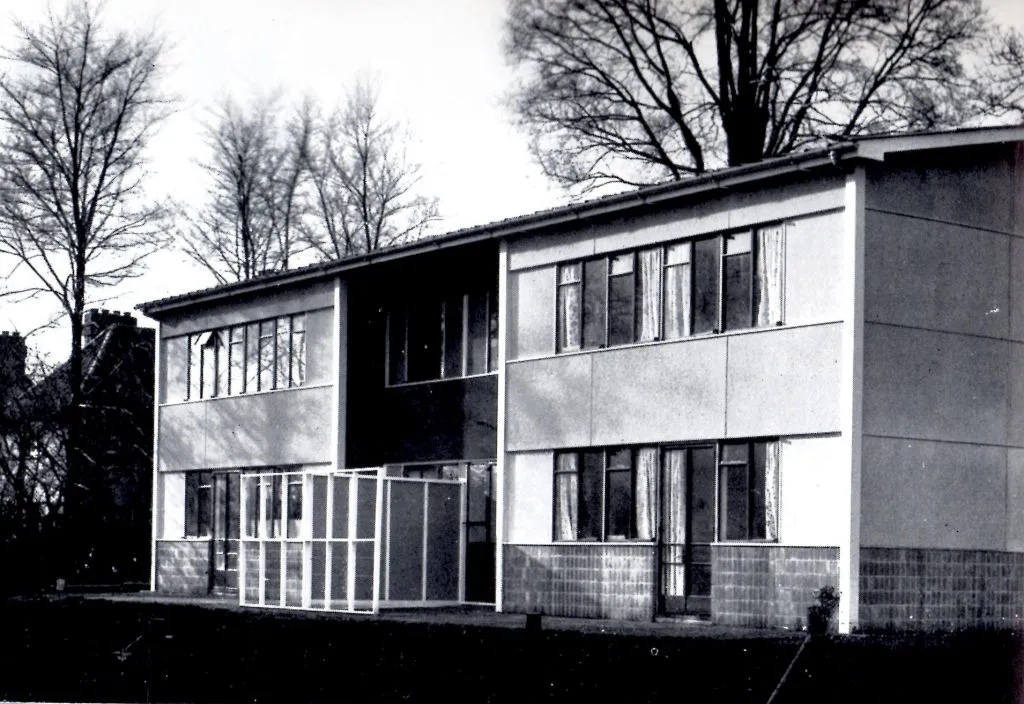Varsity Line
• "The Varsity Line and the lines it meets. Disused or freight-only sections are in blue." Source of svg file: Wikipedia (2008)
- "Cambridge—Milton Keynes loose links may well provide additionsl fragmented educational servicing web (cf. Atom, AD 5/68)."
- (Cedric Price, AD 5/69)
[edit] Introduction
When I first started my slot as Designing Buildings' Guest Editor I searched the site using the term 'Varsity Line'. There's a particular and personal reason for this: I worked in Oxford and lived In Cambridge (late nineties) and there was no direct railway route linking these university cities - in this particular case the line between Bicester and Oxford was closed to passengers and the line from Bedford (Goldington Power Station) to the junction at Cambridge was closed completely. In fact, I don't think anyone had seriously considered an alternative to travel by road.
The results of my search on the site stated:—
- "This page does not exist. Click here to create the page "Varsity Line"
I therefore created the page "Varsity Line" with a copy of the image shown above:—
- 10:42, 11 March 2024 Archiblog (Talk | contribs) (274 bytes) (Created page with "File:Item 24789 - Varsity Line.png • The Varsity Line and the lines it meets. Disused or freight-only sections are in blue. (By Dtcdthingy - Own work, CC BY-SA 3.0) [[http...")
My next step was to search the web using the same term - see Appendix.
Below are my reasons for having chosen two articles describing the Varsity Line.
[edit] Why have I chosen the following articles?
I have chosen two related articles:—
- Wikipedia contributors (last edited 12 March 2024, at 12:16) 'Varsity Line', Wikipedia;
- Disused Stations contributors (last updated 2019-06-10) 'Disused Stations', disused-stations.org
[edit] Wikipedia contributors (last edited 12 March 2024, at 12:16) 'Varsity Line'The Varsity Line was the main railway line that linked the English university cities of Oxford and Cambridge before January 1968. The article draws my attention because of my interest in the need to reconstruct the line as part of an egalitarian educational system. According to the Wikipedia article entitled 'Varsity Line', the railway was built by three local schemes, namely:—
• Table 1: The three sections which became incorporated into the London and North Western Railway (LNWR). [5] In 1923, the LNWR became a constituent of the London, Midland and Scottish (LMS) railway, one of the 'Big Four' group of companies [6] According to Wikipedia, there were also five intersecting trunk lines running north-south, namely:–
In addition, two other trunk routes were built later, namely:—
In 1948, the LMS was nationalised to form part of British Railways [9] as a result of the Transport Act 1947 [10]. [edit] Disused Stations contributors (last updated 2019-06-10) 'Disused Stations'The Disused Stations website draws my attention because of my interest in the Varsity Line and in the reconstruction of the Bedford-Cambridge section in particular. In addition to photographs it also provides maps and detailed information about all of these stations.
• Table 2: Disused stations on the Bedford-Cambridge section of the Varsity Line. |
[edit] Notes
[1] Wikipedia contributors (2024) 'Bedford Railway', in 'Varsity Line', Wikipedia.
[2] Wikipedia contributors (2024) 'Buckinghamshire Railway', in 'Varsity Line', Wikipedia. (Also 'Buckinghamshire Railway', Wikipedia.)
[3] Wikipedia contributors (2024) 'Bedford and Cambridge Railway', in 'Varsity Line', Wikipedia. According to Wikipedia:—
- "(the Bedford and Cambridge Railway) adopted the alignment of an earlier private scheme, the Sandy and Potton Railway."
See also note [4] below.
[4] Wikipedia contributors (2023) 'Sandy and Potton Railway', in 'Potton railway station', Wikipedia.
[5] Wikipedia contributors (2024) 'London and North Western Railway', Wikipedia.
[6] Wikipedia contributors (2023) 'Big Four (British railway companies)', Wikipedia.
[7] Wikipedia contributors (2024) 'The Bicester cut-off', Wikipedia.
[8] Wikipedia contributors (2024) 'Great Central Main Line', Wikipedia.
[9] Wikipedia contributors (2024) 'British Rail', Wikipedia.
[10] Wikipedia contributors (2024) 'Transport Act 1947', Wikipedia.
[edit] Reference
Wikipedia contributors (2024) 'Varsity Line', Wikipedia.
[edit] Further reading
Wikimedia Commons contributors (2018) 'Category:Varsity Line', Wikimedai Commons.
[edit] Appendix (incomplete)
Frearson, A. (2017-11-30) 'Oxford and Cambridge need good design to become "UK's Silicon Valley" say architects', dezeen.
Berkshire, Buckinghamshire & Oxfordshire Wildlife Trust (2018-09-27) 'BBOWT launches legal challenge against government's Oxford to Cambridge Expressway proposal', Berkshire, Buckinghamshire & Oxfordshire Wildlife Trust.
Harrabin, R. (2018-10-27) 'Oxford-Cambridge Arc: Row over central England mega-plan', BBC.
Bidwells (2018-04-05) 'Introducing the Oxbridge Growth Corridor', bidwells.co.uk
Kindersley, S. (2018-10-22) 'Open Letter to Mr R Brighouse', CamBedRailRoad.
Beament, E. (2018-10-27) 'Campaigners warn thousands of acres of woodland could be destroyed by Oxford to Cambridge development', Cambridgeshire News.
Johnson, B. (2018-09) 'Notes on Preliminary Railway Alignment', CamBedRailRoad.
The countryside charity (2018-10-25) 'Cambridge – Milton Keynes – Oxford: A Corridor of Uncertainty for the Countryside', cpre.org.uk
East West Rail (2019-01) 'Eastern Section: Prospectus for Growth', East West Rail.
East West Rail (2019-01) 'East West Rail Bedford to Cambridge Route Option Consultation', East West Rail.
East West Rail (2019-01) 'East West Rail Bedford to Cambridge Route Option Consultation: Route Option Maps', East West Rail.
East West Rail (2019-01) 'East West Rail Bedford to Cambridge Route Option Consultation: Technical Report', East West Rail.
CamBedRaiRoad (2019-01) 'Arguments for a Northern Approach into Cambridge', CamBedRailRoad.
CamBedRaiRoad (undated) 'EWR – CS: CBRR route & Cambridge North Station', CamBedRailRoad.
CamBedRaiRoad (undated) 'CamBedRaiRoad Proposal', CamBedRailRoad.
Berkshire, Buckinghamshire & Oxfordshire Wildlife Trust (2021-03-18) 'The Oxford to Cambridge Expressway: a threat to wildlife', Berkshire, Buckinghamshire & Oxfordshire Wildlife Trust.
Lock, D. (2023) 'Oxford MK Cambridge (O2C)', David Lock Associates.
Bidwells (2024) 'Oxford to Cambridge Arc', bidwells.co.uk
CamBedRaiRoad (2024) 'CBRR's Guidance Notes and more detailed maps', CamBedRailRoad.
--Archiblog 11:00, 20 Mar 2024 (BST)
- "A firm re-assessment of housing requirements together with an avoidance in the first stage of development of any civic design indicates the real order of priorities."
- (Cedric Price, 1966, 'PTb', AD 10/66, p.484)
|
The first thing is the title: 'Housing in the UK'. In 1965, the High Authority of the European Coal and Steel Community sponsored a competition entitled:—
According to the CCA:—
|
|
[edit] • EXPEDIENCY ON TRIAL
In 1965, the High Authority of the European Coal and Steel Community sponsored a competition entitled:—
According to the CCA:—
|
The first thing is the title: 'Housing in the UK'.
Thus this article rethinks the architectural contribution of Cedric Price.The term has been taken from the
assumes:
- ... that 'Expediency' was the underlying hypothesis constructed by Cedric Price as a basis for further ongoing research.
This term was used by Cedric Price in 'Expediency' ...
This article ... Housing in the UK / it has been selected for further investigation*.
- NOTE: In the same investigation* ...
- ... that the short life housing study was a working hypothesis constructed by Cedric Price as a basis for further ongoing research.
- ... that the system designed by Cedric Price can achleve relevance; and
- ... that it requires a re-think and updated commentary.
This article assumes:—
- ... that housing in the UK is in crisis; and
- ... that the short life housing study proposed by Cedric Price is a solution.
Key terms:—
- 'human-conditioning'
- 'socio-political'
This article assumes:—
- ... that the short life housing study was a working hypothesis constructed by Cedric Price as a basis for further ongoing research.

|

|
|
In 1965, the High Authority of the European Coal and Steel Community sponsored a competition entitled:—
According to the CCA:—
|
Notes or Comment |
Cedric Price's outline was published in 1969, thus this article assumes:—
- ... that both 'Expediency' and the short life housing study require rethinks and updated commentaries.
Housing in the UK has therefore been selected as a starting point for further ongoing research.
ANALYSIS OF EXPEDIENCY
|
[edit] 1869
"St Martin’s Cottages, completed in 1869 in Ashfield Street, Vauxhall – the first council housing to be built in England."

|

|

|
The ‘cottages’ were tenements – 146 flats and maisonettes in two four-storey blocks, brick-built with open staircases and separate WCs placed on the half-landings. The result was so bleak that even the trade magazine The Builder concluded that those who built for the poor should ‘mix a little philanthropy with their per-centage calculations’. |
[edit] Housing in the UK - BEFORE 1967
For example:—
According to the NeiroLaunch editorial team:—
- "Human conditioning is a particularly fascinating area of study. We’re not just passive recipients of stimuli; our cognitive abilities allow us to reflect on and even manipulate our own conditioning processes. This is where concepts like high order conditioning come into play, showing how we can form associations not just with direct stimuli, but with more abstract concepts and ideas."
- [1]
- "Human conditioning is everywhere, often operating behind the scenes of our daily lives. It’s in the way our favorite song makes us feel instantly happier, or how the sight of a dentist’s chair can make our palms sweat. But unlike our canine counterparts, we humans bring an extra ingredient to the mix: cognition."
- [2]
This article shares an aspiration stated in The Observer on 26 January 2025 by George Monbiot, namely:—
- "...to see lots of new social and genuinely affordable housing built as part of a massive programme to solve the worst housing crisis of any wealthy country."
- [1]
• ARBITRARY ...
According to Steve Howell, writing in Big Issue:—
- "...the number of companies accounting for more than half of all private sector housebuilding is set to fall from 10 at the start of the decade to six: Taylor Wimpey, Persimmon, Barratt Redrow, Vistry, Bellway and Berkeley."
- [2]
|
• Wendel View, Wellingborough, aerial view of estate Learn More |
Notes Barratt Redrow |
|
Learn More |
Notes Bellway |
|
Learn More |
Notes Berkeley |
|
Learn More |
Notes Persimmon |
|
Learn More |
Notes Taylor Wimpey |
|
Learn More |
Notes Vistry (formerly Bovis) |
- * DOMESTIKIT: UK Begun January 1972, first iteration finished 1977.
[edit] References
- Savills News (2024) 'UK housing value dips by a marginal -0.3% to £8.678 trillion', Savills
- Shelter (2009) 'Factsheet: Housing Tenure', shelter.org
- NeuroLaunch editorial team (2024) 'High Order Conditioning: Exploring Advanced Learning Processes in Psychology', NeuroLaunch.com
- NeuroLaunch editorial team (2025) 'Conditioning: A Comprehensive Guide to Its Meaning and Applications', NeuroLaunch.com
- NeuroLaunch editorial team (2025) 'Pavlov Conditioning: From Dogs to Humans – The Science of Learned Responses', NeuroLaunch.com
- George Monbiot (2025) 'Home truths: the only thing Labour is building is a bigger, more dysfunctional housing market', The Observer, 26 January
- George Monbiot (2025) 'Homing Device', monbio.com
- Steve Howell (2024) 'How Labour's housebuilding target of 1.5 million new homes hinges on just six private companies', Big Issue, 26 July
[edit] Bibliography
Aditya Chakrabortty (2025) 'Call it Thatcher’s timebomb: the great council housing selloff, a crisis hidden in plain sight', The Guardian, 13 February
Charlotte Crouch (2022) 'What does it mean to be a Guest Editor today?', Linkedin
Norman Fellows (2023) 'File 081: Housing Research - CP Ordering / CCA', Google Drive
Burnett, John (1986) 'A social history of housing, 1815-1985', London ; New York : Methuen
Anderson, A (2019) 'Good Life Now - Leisure and Labour in Cedric Price's Housing Research, 1966-1973', Footprint
Norman Fellows (2023) 'Housing Research by Cedric Price', Designing Buildings
MHCLG (2024) 'National Planning Policy Framework', gov.uk
Sharon Jane Taylor (2024) 'Building the homes we need', UK Parliament
Matthew Pennycook (2024) 'Building the homes we need', UK Parliament
Shelter (2019) 'Building for our Future: A Vision for Social Housing', Shelter
Shelter (2019) 'Three million new social homes key to solving housing crisis', Shelter
Trident Modular Housing (2025) 'Need a Home or a Garden Room? Faster. Smarter. Better', Trident Modular Housing
George Sandeman (2024) '‘Perfect storm’ blocking thousands of desperately needed social homes', BBC News
Sammy Gecsoyler (2024) 'Labour plan for 1.5m new homes is not feasible, housebuilding firm says', The Guardian, 14 December
Alexandra Hasek (2021) 'Are prefabricated houses the solution to the UK’s housing crisis?', PlanRadar
Yashika Narula and Stephen Finnegan (2024) 'Can light gauge steel frame (LGSF) modular housing achieve net zero and support the UK social housing crisis?', Journal of Building Engineering
Cedric Price (1967) ‘A change is required in our current attitude to “Housing”’, Architectural Design, May, in extremelyprovocative.wordpress.com
Cedric Price (1969) 'Expediency', AD 9/69
George Monbiot (2019) 'Land for the many', Labour Party
Rachael Williamson and John Perry (2023) 'How we can end the housing crisis and fix the UK, explained', Big Issue, 11 September
Rowan Moore (2023) 'Property', The Guardian Bookshop
Rowan Moore (2023) 'From right to buy to housing crisis: how home ownership killed Britain’s property dream', The Guardian, Sun 29 Oct 2023 07.00 GMT
Rowan Moore (2025) 'Peace, permanence and affordable prices: six ways to solve Britain’s housing crisis', The Observer (Guardian), 1 February
Strutt & Parker (2018) 'Can modular homes solve the UK's housing crisis?', Strutt & Parker
Wikipedians (2025) 'Housing in the United Kingdom', Wikipedia
- ** *** Debates on high-rise housing
- ** *** Ownership
- ** Post War
According to Wikipedians:—
- "Housing in the United Kingdom represents the largest non-financial asset class in the UK; its overall net value passed the £8 trillion mark in 2023. This reflects a marginal decrease of 0.3% from the previous year, yet it remains £1.585 trillion higher than pre-pandemic levels in 2019. [1] Housing includes modern and traditional styles. About 30% of homes are owned outright by their occupants, and a further 40% are owner-occupied on a mortgage. About 18% are social housing of some kind, and the remaining 12% are privately rented. [2007] [2]
- The UK ranks in the top half in Europe with regard to rooms per person, amenities, and quality of housing.[3][4] However, the cost of housing as a proportion of income is higher than average among EU countries,[3] and the increasing cost of housing in the UK may constitute a housing crisis for many especially in London,[5][6][7] — the rate of over fivefold house price increases far exceeding the inflation rate of just little above twofold over the last three decades[8][9] — with housing nationally being typically the larger driver of inflation over the three decades preceding 2022 compared to food and non-alcoholic beverages. [10]
- Housing and planning decisions are administered by local authorities, but overall comes under the jurisdiction of the Minister of State for Housing as part of the Ministry of Housing, Communities and Local Government at Whitehall in England,[11] with the responsibilities as Devolution devolved matters to corresponding departments in the Scottish Government at Holyrood, the Welsh Government at the Senedd in Cardiff, and the Northern Ireland Executive at Stormont, responsible for communities and local government in their respective jurisdictions."
- (Wikipedians, 2025. 'Housing in the United Kingdom', Wikipedia)
However,
In September 1969 AD published a special issue entitled:—
- Despite popular demand . . .
- . . . AD is thinking about architecture and planning
The issue contained an outline taken from Cedric Price's short life housing study which illustrated some of the factors and orientations used to produce and test his solutions, namely:—
- 'Expediency'
- (Cedric Price, AD 9/69, p.493)
- "After the Second World War a new type of state-subsidized house appeared in Britain. The two-bedroom temporary bungalow was produced ostensibly to provide much needed housing in the immediate post-war period and some 156,623 houses were supplied between 1945-1949 as part of the scheme. The bungalows differed from pre-war state-subsidized housing in a number of ways including their method of construction.For the first time in Britain one of the ideals of the Modern Movement was realized: a house was manufactured on a production line in a factory.
vvv
|
Housing in the UK was selected for investigation by Cedric Price for a personal reason, namely:—
• Highlighted clipping from the article |
Notes "Housing thus saturated with the implications of such questions is seen in a 'problem solving' context to be infinitely regressive.
|
The term 'popular demand' may be defined as:—
- a request made by or a desire shared by many people (MW)
- when a lot of people have asked for something to be done, performed etc (Longman)
This begs a couple of questions, namely:—
- What demand?
- How was such demand created?
- "Housing in the UK has been selected for investigation* since I consider it a critical element of the man-made environment which through prolonged misrepresentation and mis-applied design theory has become probably the least sensitive element of artificial human-conditioning."
- [...]
- * SHORT LIFE HOUSING STUDY—U.K. Begun January 1967, due to finish 1969."
- (ib.)
AD September 1969 was a special issue entitled:—
- Despite popular demand . . .
- . . . AD is thinking about architecture and planning
It continued the paradigm shift of AD (Architectural Design) in the late 1960s and early 1970s from a 'professional' magazine to a 'little' magazine identified by Norman Fellows. [1]
The title ... a mismatch between popular demand and the paradigm shift of AD (Architectural Design).
The mismatch suggested in the title is encapsulated in the opening paragraph of the architectural contribution made by Cedric Price (left):
- "Housing in the UK has been selected for investigation* since I consider it a critical element of the man-made environment which through prolonged misrepresentation and mis-applied design theory has become probably the least sensitive element of artificial human-conditioning."
Given the crisis affecting housing in the UK today, this article assumes:
- ... that the equation between popular demand and architecture/planning in the 2020s is still not valid.
The issue contained an outline taken from Cedric Price's short life housing study which illustrated some of the factors and orientations used to produce and test his solutions, namely:—
- 'Expediency'
- (Cedric Price, AD 9/69, p.493)
The paradigm shift signified by the title is exemplified in the architectural contribution made by Cedric Price, namely:—
- 'Expediency'. (See left)
- "Housing in the UK has been selected for investigation* since I consider it a critical element of the man-made environment which through prolonged misrepresentation and mis-applied design theory has become probably the least sensitive element of artificial human-conditioning."

|

|

|

|

|
mmm
Featured articles and news
Amendment to the GB Energy Bill welcomed by ECA
Move prevents nationally-owned energy company from investing in solar panels produced by modern slavery.
Gregor Harvie argues that AI is state-sanctioned theft of IP.
Heat pumps, vehicle chargers and heating appliances must be sold with smart functionality.
Experimental AI housing target help for councils
Experimental AI could help councils meet housing targets by digitising records.
New-style degrees set for reformed ARB accreditation
Following the ARB Tomorrow's Architects competency outcomes for Architects.
BSRIA Occupant Wellbeing survey BOW
Occupant satisfaction and wellbeing tool inc. physical environment, indoor facilities, functionality and accessibility.
Preserving, waterproofing and decorating buildings.
Many resources for visitors aswell as new features for members.
Using technology to empower communities
The Community data platform; capturing the DNA of a place and fostering participation, for better design.
Heat pump and wind turbine sound calculations for PDRs
MCS publish updated sound calculation standards for permitted development installations.
Homes England creates largest housing-led site in the North
Successful, 34 hectare land acquisition with the residential allocation now completed.
Scottish apprenticeship training proposals
General support although better accountability and transparency is sought.
The history of building regulations
A story of belated action in response to crisis.
Moisture, fire safety and emerging trends in living walls
How wet is your wall?
Current policy explained and newly published consultation by the UK and Welsh Governments.
British architecture 1919–39. Book review.
Conservation of listed prefabs in Moseley.
Energy industry calls for urgent reform.

















































